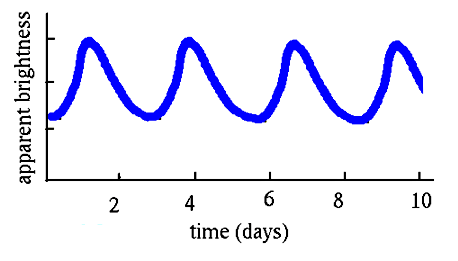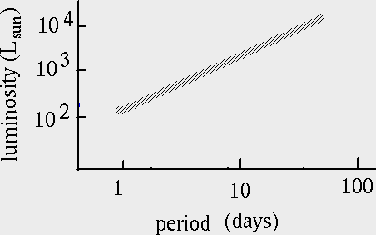![]()
Cepheids, also called Cepheid Variables, are stars which brigthen and dim periodically. This behavior allows them to be used as cosmic yardsticks out to distances of a few tens of millions of light-years.

In 1912, Henrietta Swan Leavitt noted that 25 stars, called Cepheid stars, in the Magellanic cloud would brighten and dim periodically. Leavitt was able to measure the period of each star by measuring the timing of its ups and downs in brightness. What she determined was that the brighter the Cepheid, the longer its period. In fact, Cepheids are very special variable stars because their period (the time they take to brighten, dim and brighten again) is

Cepheids are reasonably abundant and very bright. Astronomers can identify them not only in our Galaxy, but in other nearby galaxies as well. If one requires the distance to a given galaxy one first locates the Cepheid variables in this galaxy. From these observations one determines the period of each of these stars. Leavitt's data states that a given period has a unique brightness associated to it. So from the period and Leavitt's plot we get the brightness at the distance of one light-year (see the image above). We can also measure the brightness on Earth. The brightness at the distance of one light-year will be larger than the observed brightness due to the fact that brightness drops like the square of the distance. From these numbers one can extract the distance to the stars. This method works up to 13 million light-years when Earth-bound telescopes are used; for larger distances these stars become too dim to be observed. Recently, space-based telescopes such as the Hubble Telescope, have used these stars to much farther distances. Looking at a galaxy in the Virgo cluster called M100, astronomers used the Cepheid variables observed there to determine its distance - 56 million light-years.
![]()
The StarChild site is a service of the High Energy Astrophysics Science Archive Research Center (HEASARC), within the Astrophysics Science Division (ASD) at NASA/ GSFC.
StarChild Authors: The StarChild Team
StarChild Graphics & Music: Acknowledgments
StarChild Project Leader: Dr. Laura A.
Whitlock
Curator:
Responsible NASA Official: